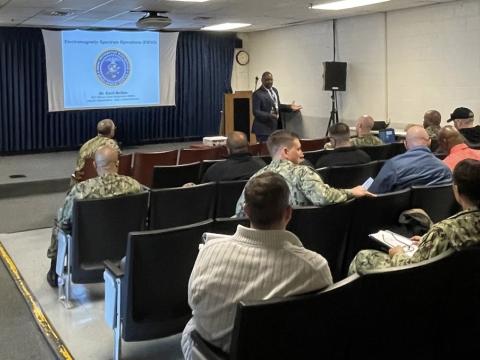Vehicle Flies Rapidly Into The Next Generation
 |
Depiction of Boeing Company’s Phantom Ray technology demonstrator, which will serve as a testbed for advanced unmanned aircraft systems. |
An aircraft developed by a
The Phantom Ray demonstrator evolved out of the Boeing Company’s efforts on the Defense Advanced Research Projects Agency/U.S. Air Force/U.S. Navy Joint-Unmanned Combat Air Systems (J-UCAS) program, which was cancelled in 2006. Boeing’s role in the work involved creating the X-45A, which successfully flew 64 times from 2002 to 2005, including a demonstration exercise with two X-45A aircraft that was the first unmanned, autonomous multivehicle flight controlled by a single pilot. Boeing also created the larger X-45C aircraft as part of J-UCAS, and that model will serve as the basis for the Phantom Ray.
Dave Koopersmith, vice president of Boeing Advanced Military Aircraft, emphasizes that the Phantom Ray is based on the X-45C, but it is not the same aircraft. Work on the project began two years after the previous program came to an end. Much of what was done or envisioned to be done on the X-45C is not part of the Phantom Ray project. However, Koopersmith shares that Boeing is building on work accomplished for J-UCAS, such as the hardware safety and flight certification efforts, using rapid prototyping techniques to move the platform forward. Boeing had to complete work on several key systems including vehicle management, communication control software and the open mission management command and control segment. “So it leverages off of that work but now moves into rapid prototyping,” Koopersmith says.
The rapid prototyping enables the company to learn about and explore technologies without the same level of testing involved in formal engineering, manufacturing and development activities. In that type of activity, projects undergo meticulous checks and balances in programs intended to be low risk and to move directly to low-rate initial production programs. That process is a common way of doing business but lengthens development time. The quicker approach Boeing is using for this project does not involve the full set of test rigor.
The use of rapid-prototyping techniques enables the company to roll out the aircraft in a constrained time period. Laboratory testing for the Phantom Ray air vehicle is scheduled for late this year with ground testing commencing in 2010, and the first flight occurring in December of that year. All the systems required to operate the aircraft will be on board for initial testing, with other systems added as time goes on. The vehicle is scheduled to conduct five to 10 initial flights over a six-month period. Koopersmith says officials with the program will judge it successful initially if the flying takes place approximately or exactly on time and if the Phantom Ray completes the number of test flights envisioned. Additional success will be judged as time and uses progress.
Koopersmith describes the Phantom Ray as the personification of rapid-prototyping activity. As developers evolve the platform from types of tooling they are using, to types of test procedures they will use, to types of software they are developing to fly the vehicle, they accomplish through that work the maturation of the processes and techniques necessary. They also try to work quickly to develop cost-effective techniques for developing testing and flying prototype kinds of systems.
According to Koopersmith, the development of the Phantom Ray is a crawl-walk-run approach in which subsystems are tested first in the laboratory, followed by ground and taxi tests. When officials are comfortable with the results of those testing levels, then the Phantom Ray will be ready to fly. This procedure is standard for unmanned and manned vehicles in this type of system set. Currently developers are working in the laboratories on vehicle management software.
Boeing’s decision to invest in such a vehicle at this point is driven by the evolving battlefield and increased use of unmanned systems. “We see that now and in the future the customer will need these capabilities,” Koopersmith explains. “Unmanned vehicles have clearly become an integral part of warfighting strategies. We want to undertake Phantom Ray to mature and evolve those technologies.”
Koopersmith says Boeing is continuing its focus on the unmanned systems field and is working to identify future gaps in what customers need. He adds that the Phantom Ray is a natural fit for this strategy especially with the previous activities to build on. Evolving a product from the X-45 program will enable the company to mature and explore unmanned technologies in an autonomous fighter-sized aircraft. The Phantom Ray will be autonomous, rather than unmanned, with the human element serving more as a coach giving direction than a pilot operating a stick and throttle to actively fly the platform from the ground. The project is being worked entirely by Boeing, which will provide the test team members to operate the vehicle. The Phantom Ray is intended to serve as a testbed to examine systems and technology, not as a vehicle to one day fly missions itself.
 |
The X-45A was developed by Boeing for the Joint-Unmanned Combat Air Systems (J-UCAS) program. Boeing is leveraging work from the cancelled J-UCAS to develop the Phantom Ray, an autonomous vehicle testbed for advanced air systems technology. |
As the company matures the program, flies the vehicle and eventually enters into talks with potential customers, it takes a proactive approach to influencing what is to come in the field. “For us, it’s about continuing to explore the technology and shape the future,” Koopersmith shares. And though the company is preparing for the times ahead, it is not trying to predict them. Rather than planning for the specific applications to be evaluated, Boeing officials are leaving those decisions up in the air. The unique systems placed into the Phantom Ray for assessment will be determined by customers’ interest as they prepare to employ the aircraft.
No business model for the aircraft’s use has yet been set, but Koopersmith does say that the focus has been on Defense Department users, not other members of industry. Customers can use the Phantom Ray to test any applications they want to assess on an unmanned fighter-size vehicle. Boeing has pallets designed to be installed in the weapons bays, but the platform also can accommodate other types of equipment. “I hesitate to limit what customers might want to explore,” Koopersmith states.
As the company is moving the Phantom Ray program forward, it is mindful of the challenges development faces, especially because of its experience flying the X-45A vehicle. “I think we understand the complexities of getting this size of vehicle in the air in this timeline and exploring the advanced technologies we’ll be driving,” Koopersmith says. The Phantom Ray poses uncommon problems because of its size, which is larger than the X-45A, and its particular shape. Rather than a traditional fuselage, wing and vertical and horizontal tails construct, the aircraft looks more like a flying wing. “This size vehicle, with this shape of vehicle, will be a unique space for us,” Koopersmith explains.
The Phantom Ray is not the only unmanned vehicle development at Boeing, and it is part of an overarching strategy of unmanned activity at the company. Boeing recently adjusted its approach to unmanned technologies when the Boeing Military Aircraft Business unit announced the formation of an Unmanned Airborne Systems division in June at the Paris Air Show. The division will take over the A160T Hummingbird, Unmanned Little Bird and SolarEagle (Vulture) programs. Koopersmith explains that this move demonstrates his company’s dedication to the unmanned arena, even though Boeing has been involved in the field for decades. He states that bringing this division to bear drives synergy and focus in unmanned systems across the board.
WEB RESOURCES
Boeing Integrated Defense Systems: www.boeing.com/ids
Joint-Unmanned Combat Air Systems: www.darpa.mil/j-ucas




Comments